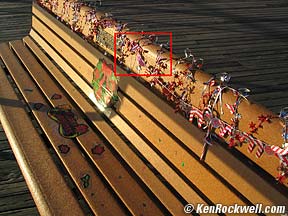rubiksc00p
Senior Member
This is a wonderful snippet from Ken Rockwell, a fantastic photographer who likes to always say the best pictures come from the photographer not the camera.
In addition to what he said below, on our mobile camera's the sensors are only made for 5mp usually anyway, so they lose quality as the megapixels increase.
The Myth
The megapixel myth was started by camera makers and swallowed hook, line and sinker by consumers. Camera makers use the number of megapixels a camera has to hoodwink you into thinking it has something to do with camera quality. They use it because even a tiny linear resolution increase results in a huge total pixel increase, since the total pixel count varies as the total area of the image, which varies as the square of the linear resolution. In other words, an almost invisible 40% increase in the number of pixels in any one direction results in a doubling of the total number of pixels in the image. Therefore camera makers can always brag about how much better this week's camera is, with even negligible improvements.This gimmick is used by salespeople and manufacturers to you feel as if your current camera is inadequate and needs to be replaced even if the new cameras each year are only slightly better.One needs at least a doubling of linear resolution or film size to make an obvious improvement. This is the same as quadrupling the megapixels. A simple doubling of megapixels, even if all else remained the same, is very subtle. The factors that matter, like color and sharpening algorithms, are far more significant.The megapixel myth is also prevalent because men always want a single number by which something's goodness can be judged.Unfortunately, it's all a myth because the number of megapixels (MP) a camera has has very little to do with how the image looks. Even worse, plenty of lower MP cameras can make better images than poorer cameras with more MP.
The Hype
Here's a complete fabrication by a company who is trying to spread the myth to get you to buy too much camera. That page is brilliantly done, however it's done with completely fraudulent data to exaggerate the differences. At the low magnifications shown on the screen any and all of those examples should look perfect. Instead the two lower resolution examples have been deliberately degraded to make them look worse. Their page displaying results for a 5 x 7" print actually show how the 4 MP camera would look blown up to 12 by 9 feet, not 5 x 7 inches!How do we know their 4MP example is what you'd see blown up twelve feet wide, not 5 x 7 inches? Easy: for the 4 MP example at maximum crop I see pixels blown up to little squares measuring 16 pixels per inch on my screen. (Just get out your ruler and measure for yourself.) You divide the number of pixels by the PPI (DPI) to get how many inches you get in print at that resolution. Thus printing a 2,289 x 1,712 pixel (4MP) image at 16 PPI gives (2289/16)" x (1712/16)" or 143" x 107" or, dividing inches by 12 to get feet, 12' x 9.'I'm sure the designer of that page would feign ignorance of the technology involved if made to own up to it. Page designers don't have Ph.D.s in digital image processing, either. Most likely the designer worked on it till their manager made sure that they showed a clear difference. Their manager, if made to come clean, would probably explain that the page was put up to illustrate the differences as an educational service, not as actual science or a legitimate example. They had to make certain "adjustments" to make the differences clear, namely, to make the 4 MP and 5 MP cameras look much worse than they are.I taught you above how to calculate the differences among different resolution cameras. The difference between the 6 MP and 4 MP cameras should be (square root (6/4)) or SQR(1.5) or 22.4%. In other words, the size of the pixels or number per inch should be less than 25% different between the 4 MP and 6 MP cameras. They've made the lower resolution cameras look much, much worse by comparison on that page
.Honest Results for Comparison
[TABLE="width: 600"]
[TR]
[TD]

[/TD]
[TD]

[/TD]
[/TR]
[TR]
[TD]3 MP uncropped
[/TD]
[TD]Cropped as per red rectangle
[/TD]
[/TR]
[/TABLE]
Here's the same percentage crop as that other store-sponsored website shows. I gave them an advantage by showing my images above at twice the size as they did (requiring four times the number of pixels) and then starting with only a 3 MP camera, not the 4 MP as shown in their worst example.
Looks fine, eh? I actually had to throw many pixels away. These sizes are easy to do with a 3 MP camera. Even if they are adding in some unstated magnification to try to address other issues in rendering prints vs. screen images the differences between 4 MP and 6 MP are nowhere near as exaggerated as that store site shows. They show at least a 4x difference in the size of the pixels between 4 MP and 6 MP. As you know the size difference between 4 MP and 6 MP is only 50% in pixel count, and since pixels are square that means less than 25% in pixel size or pitch! Since that part of that retailer's site isn't an ad for any particular product I doubt and truth in advertising rules apply. Caveat emptor!
Go read the whole article!
Source: The Megapixel Myth
In addition to what he said below, on our mobile camera's the sensors are only made for 5mp usually anyway, so they lose quality as the megapixels increase.
The Myth
The megapixel myth was started by camera makers and swallowed hook, line and sinker by consumers. Camera makers use the number of megapixels a camera has to hoodwink you into thinking it has something to do with camera quality. They use it because even a tiny linear resolution increase results in a huge total pixel increase, since the total pixel count varies as the total area of the image, which varies as the square of the linear resolution. In other words, an almost invisible 40% increase in the number of pixels in any one direction results in a doubling of the total number of pixels in the image. Therefore camera makers can always brag about how much better this week's camera is, with even negligible improvements.This gimmick is used by salespeople and manufacturers to you feel as if your current camera is inadequate and needs to be replaced even if the new cameras each year are only slightly better.One needs at least a doubling of linear resolution or film size to make an obvious improvement. This is the same as quadrupling the megapixels. A simple doubling of megapixels, even if all else remained the same, is very subtle. The factors that matter, like color and sharpening algorithms, are far more significant.The megapixel myth is also prevalent because men always want a single number by which something's goodness can be judged.Unfortunately, it's all a myth because the number of megapixels (MP) a camera has has very little to do with how the image looks. Even worse, plenty of lower MP cameras can make better images than poorer cameras with more MP.
The Hype
Here's a complete fabrication by a company who is trying to spread the myth to get you to buy too much camera. That page is brilliantly done, however it's done with completely fraudulent data to exaggerate the differences. At the low magnifications shown on the screen any and all of those examples should look perfect. Instead the two lower resolution examples have been deliberately degraded to make them look worse. Their page displaying results for a 5 x 7" print actually show how the 4 MP camera would look blown up to 12 by 9 feet, not 5 x 7 inches!How do we know their 4MP example is what you'd see blown up twelve feet wide, not 5 x 7 inches? Easy: for the 4 MP example at maximum crop I see pixels blown up to little squares measuring 16 pixels per inch on my screen. (Just get out your ruler and measure for yourself.) You divide the number of pixels by the PPI (DPI) to get how many inches you get in print at that resolution. Thus printing a 2,289 x 1,712 pixel (4MP) image at 16 PPI gives (2289/16)" x (1712/16)" or 143" x 107" or, dividing inches by 12 to get feet, 12' x 9.'I'm sure the designer of that page would feign ignorance of the technology involved if made to own up to it. Page designers don't have Ph.D.s in digital image processing, either. Most likely the designer worked on it till their manager made sure that they showed a clear difference. Their manager, if made to come clean, would probably explain that the page was put up to illustrate the differences as an educational service, not as actual science or a legitimate example. They had to make certain "adjustments" to make the differences clear, namely, to make the 4 MP and 5 MP cameras look much worse than they are.I taught you above how to calculate the differences among different resolution cameras. The difference between the 6 MP and 4 MP cameras should be (square root (6/4)) or SQR(1.5) or 22.4%. In other words, the size of the pixels or number per inch should be less than 25% different between the 4 MP and 6 MP cameras. They've made the lower resolution cameras look much, much worse by comparison on that page
.Honest Results for Comparison
[TABLE="width: 600"]
[TR]
[TD]

[/TD]
[TD]

[/TD]
[/TR]
[TR]
[TD]3 MP uncropped
[/TD]
[TD]Cropped as per red rectangle
[/TD]
[/TR]
[/TABLE]
Here's the same percentage crop as that other store-sponsored website shows. I gave them an advantage by showing my images above at twice the size as they did (requiring four times the number of pixels) and then starting with only a 3 MP camera, not the 4 MP as shown in their worst example.
Looks fine, eh? I actually had to throw many pixels away. These sizes are easy to do with a 3 MP camera. Even if they are adding in some unstated magnification to try to address other issues in rendering prints vs. screen images the differences between 4 MP and 6 MP are nowhere near as exaggerated as that store site shows. They show at least a 4x difference in the size of the pixels between 4 MP and 6 MP. As you know the size difference between 4 MP and 6 MP is only 50% in pixel count, and since pixels are square that means less than 25% in pixel size or pitch! Since that part of that retailer's site isn't an ad for any particular product I doubt and truth in advertising rules apply. Caveat emptor!
Go read the whole article!
Source: The Megapixel Myth
Last edited:
